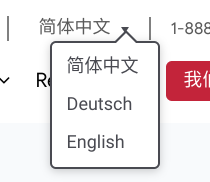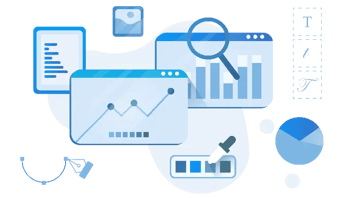Introducing the HubSpot Content Hub! Discover how HubSpot Content Hub's AI tools, personalization features & more can help you excel in content marketing.
Reach a Global Audience by Building a Multilingual Website
Expand your online visibility and reach a wider audience by creating a multilingual website. Learn how HubSpot can help you effectively translate your content and optimize it for multilingual SEO.

Understanding the Importance of a Multilingual Website
In today's interconnected world, having a multilingual website is crucial for businesses that want to reach a global audience. By offering your content marketing in multiple languages, you can effectively communicate with customers worldwide and create a more personalized experience. This not only helps to increase your website's visibility but also enhances customer satisfaction and trust.
Moreover, a multilingual site allows you to tap into new markets and expand your customer base. It opens opportunities for international partnerships, collaborations, and global business growth. By speaking your customers' language, you can break down barriers and establish stronger connections with them, leading to improved brand recognition and loyalty.
With the increasing globalization of markets, having a multilingual website has become a competitive advantage. It shows that you value diversity and are willing to cater to the needs of different cultures and languages. This can give you an edge over your competitors and position your business as a global player in your industry.
Overall, understanding the importance of a multilingual website is crucial for any business looking to expand its online presence and connect with a global audience. By investing in translation and localization, you can effectively reach customers in different countries and cultures, enhance user experience, build trust, and drive business growth.
Choosing the Right Translation Strategy
When building a multilingual website, choosing the right translation strategy is key when developing your website content and navigaton. You can take several approaches depending on your budget, resources, and target audience.
-
One option is to hire professional translators, translation services, or content creators who are native speakers of the target languages. This ensures accurate and high-quality translations that capture the nuances and cultural context of the content. However, this can be costly and time-consuming, especially if you have a large volume of content to translate.
-
Another option is using automatic translation tools like Google Translate or Microsoft Translator. While these tools have improved over the years, they still have limitations regarding accuracy and context, and your'll find that machine translations don't always make sense. Reviewing and editing the machine-translated content carefully to ensure quality is essential.
While HubSpot does not automatically translate your website content, HubSpot currently integrates with more than 16 apps with
among the popular ones.
HubSpot has several sophisticated features to support multi-lingual sites, language switchers, and SEO support.
Ultimately, the right translation strategy depends on your specific needs and goals. Are you providing all of your services in all languages? Is the supported language your project language or only your website language? Are services equally crucial in the target markets?
It's important to consider factors such as budget, quality, time constraints, and target audience preferences when deciding. By choosing the right strategy, you can effectively translate your content and provide a seamless multilingual experience for your website visitors.
You might also like:
Multilingual Website Best Practices
-
Before translating everything on your website into multiple new languages, optimize your website for one language first, e.g., have good content for every stage of the buyer's journey, optimized for SEO and conversion.
-
Unless you have an unlimited budget (or a small website) to translate your entire site into one or more languages, devise a gradual expansion. In growth-driven design mode, this would mean creating essential pages like the Homepage, About Us page, and Contact Us page.
Example: At the time of publishing this article, Aspiration Marketing is expanding content creation in English, French, German, Mandarin, and Spanish. Only for pages available in other languages, the HubSpot language switcher module offers the other language version in the drop-down menu language switcher:

-
Prioritize pages for translation that are already highly successful in your original language, the most visited blog posts, the most influential blog posts, the highest converting landing pages, etc. This assumes that they are also relevant in your targeted translated language. A page about successful YouTube or Facebook marketing will only be of little relevance in Mainland China.....
Leveraging HubSpot for Building a Multilingual Website
HubSpot offers powerful tools and features to help you create and manage a multilingual website. With HubSpot Content Hub (HubSpot's Content Management System), you can easily create and organize content in multiple languages, making it more accessible to your target audience.
Furthermore, HubSpot's CMS offers SEO optimization tools, allowing you to optimize your multilingual website for search engines. You can easily customize web pages, meta tags, URLs, and other SEO elements for each language, ensuring your website ranks well in different markets and languages.
By leveraging HubSpot for multilingual website creation, you can streamline your translation process, ensure translation consistency, and optimize your website for global SEO. This can save you time and resources while maximizing the impact of your multilingual website.
Optimizing Your Multilingual Website for SEO
Optimizing your multilingual website for SEO is crucial to ensure its visibility and reach in different markets and languages. Here are some tips to help you effectively optimize your website for search engines:
-
Conduct keyword research: Identify relevant keywords in each target language to include in your content, meta tags, and URLs. Use keyword research tools to determine search volume and competition.
-
Localize your content: Translate your content in a way that considers cultural differences and local preferences. This includes adapting your messaging, imagery, and design to resonate with your target audience in each language.
-
Customize meta tags and URLs: Optimize meta tags, meta descriptions, and URLs for each language. Include relevant keywords and ensure they accurately describe the content on each page.
-
Implement hreflang tags: Hreflang tags help search engines understand your webpages' target language. Implement these tags to indicate the language and country targeted for each page.
-
Build backlinks: Earn high-quality backlinks from reputable websites in each target language. This can improve your website's authority and visibility in search engine results.
-
Monitor and analyze: Regularly monitor your website's performance in different languages using SEO analytics tools. Track rankings, organic traffic, and conversion rates to identify areas for improvement.
By following these SEO optimization tips, you can enhance the visibility and reach of your multilingual website, attracting more organic traffic and expanding your global audience.
You might also like:
How We Use HubSpot Content Hub for SEO
Unlock SEO success: Learn how we use HubSpot Content Hub for SEO, boost rankings, increase organic traffic, and optimize our content for success.
Measuring the Success of Your Multilingual Website
Measuring the success of your multilingual website is essential to understand its impact and make data-driven decisions for improvement. Here are some key metrics to consider:
- Website traffic: Monitor the overall traffic to your multilingual website and track each language's performance. Analyze the sources of traffic and identify any variations or trends.
- Conversion rates: Measure the conversion rates for each language to assess the effectiveness of your multilingual content. Compare conversion rates across languages and optimize accordingly.
- User engagement: Analyze user engagement metrics like bounce rate, time on page, and pages per session. This can provide insights into how visitors interact with your multilingual website and help identify areas for improvement.
- SEO performance: Track the rankings and organic traffic for each language to evaluate the effectiveness of your SEO efforts. Identify keywords that are performing well and optimize for additional keywords as needed.
- Customer feedback: Collect feedback from your multilingual website visitors through surveys, feedback forms, or social media. This can provide valuable insights into their experience and help identify areas for improvement.
By regularly monitoring and analyzing these metrics, you can measure your multilingual website's success and identify optimization opportunities. This data-driven approach will help you continuously improve your website's performance and serve your global audience better.
Multilingual Website FAQs
There's no single "most effective" approach to website translation, as the best method depends on various factors like budget, target audience, website size, and content complexity. A breakdown of different approaches and their key pros and cons includes:
1. Machine Translation:
- Pros: Quick, affordable, readily available options like Google Translate or CharGPT.
- Cons: Often lacks accuracy and nuance and struggles with humor, idioms, and cultural references.
2. Human Translation:
- Pros: High quality, accurate, culturally appropriate translations.
- Cons: Expensive, time-consuming, requires finding qualified translators familiar with your target market.
3. Hybrid Approach:
- Pros: Combines affordability with quality. Use machine translation for the initial translation, then have a human reviewer edit and refine it.
- Cons: Still requires human involvement, increasing cost compared to pure machine translation.
This content is also available in:
- Deutsch: Globale Präsenz mit einer mehrsprachigen Website
- Español: Llegue a Una Audiencia Global Creando un Sitio Web Multilingüe
- Français: Atteignez un public mondial en créant un site Web multilingue
- Italiano: Raggiungere un pubblico globale costruendo un sito web multilingue
- Română: Atingeți o audiență globală prin crearea unui site web multilingv
- 简体中文: 通过多语言网站吸引全球受众

Joachim is a certified HubSpot trainer with over 13 years of experience in content marketing, strategy, website development, and SEO. He has implemented numerous large-scale, international growth marketing programs, including one with UiPath, which grew from a startup to a successful IPO on the NYSE. Joachim has special expertise in multilingual marketing and sales enablement projects, and he uses the latest AI technologies to help our clients.









Leave a Comment